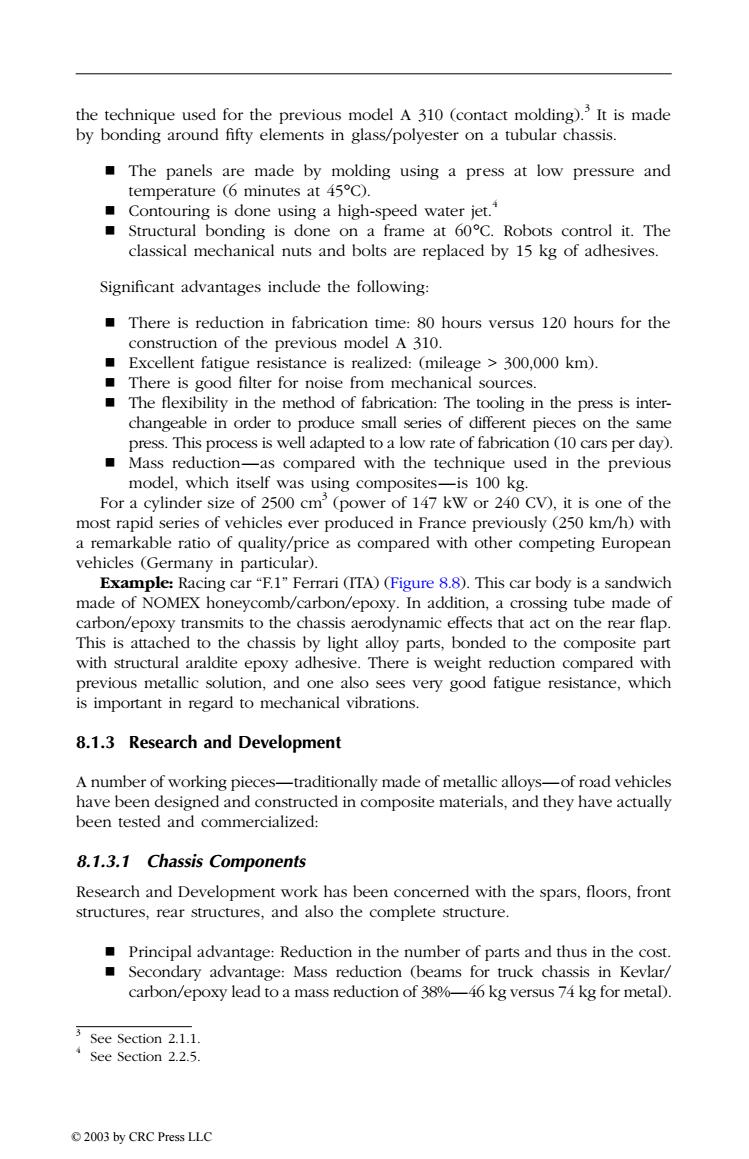正在加载图片...

the technique used for the previous model A 310(contact molding).3 It is made by bonding around fifty elements in glass/polyester on a tubular chassis. The panels are made by molding using a press at low pressure and temperature (6 minutes at 45C). Contouring is done using a high-speed water jet. Structural bonding is done on a frame at 60C.Robots control it.The classical mechanical nuts and bolts are replaced by 15 kg of adhesives. Significant advantages include the following: There is reduction in fabrication time:80 hours versus 120 hours for the construction of the previous model A 310. Excellent fatigue resistance is realized:(mileage 300,000 km). There is good filter for noise from mechanical sources. The flexibility in the method of fabrication:The tooling in the press is inter- changeable in order to produce small series of different pieces on the same press.This process is well adapted to a low rate of fabrication (10 cars per day). Mass reduction-as compared with the technique used in the previous model,which itself was using composites-is 100 kg. For a cylinder size of 2500 cm2(power of 147 kW or 240 CV),it is one of the most rapid series of vehicles ever produced in France previously (250 km/h)with a remarkable ratio of quality/price as compared with other competing European vehicles (Germany in particular). Example:Racing car"F.1"Ferrari (ITA)(Figure 8.8).This car body is a sandwich made of NOMEX honeycomb/carbon/epoxy.In addition,a crossing tube made of carbon/epoxy transmits to the chassis aerodynamic effects that act on the rear flap. This is attached to the chassis by light alloy parts,bonded to the composite part with structural araldite epoxy adhesive.There is weight reduction compared with previous metallic solution,and one also sees very good fatigue resistance,which is important in regard to mechanical vibrations. 8.1.3 Research and Development A number of working pieces-traditionally made of metallic alloys-of road vehicles have been designed and constructed in composite materials,and they have actually been tested and commercialized: 8.1.3.1 Chassis Components Research and Development work has been concerned with the spars,floors,front structures,rear structures,and also the complete structure. Principal advantage:Reduction in the number of parts and thus in the cost. Secondary advantage:Mass reduction (beams for truck chassis in Kevlar/ carbon/epoxy lead to a mass reduction of 38%-46 kg versus 74 kg for metal). 3See Section 2.1.1. See Section 2.2.5. 2003 by CRC Press LLCthe technique used for the previous model A 310 (contact molding).3 It is made by bonding around fifty elements in glass/polyester on a tubular chassis. The panels are made by molding using a press at low pressure and temperature (6 minutes at 45∞C). Contouring is done using a high-speed water jet.4 Structural bonding is done on a frame at 60∞C. Robots control it. The classical mechanical nuts and bolts are replaced by 15 kg of adhesives. Significant advantages include the following: There is reduction in fabrication time: 80 hours versus 120 hours for the construction of the previous model A 310. Excellent fatigue resistance is realized: (mileage > 300,000 km). There is good filter for noise from mechanical sources. The flexibility in the method of fabrication: The tooling in the press is interchangeable in order to produce small series of different pieces on the same press. This process is well adapted to a low rate of fabrication (10 cars per day). Mass reduction—as compared with the technique used in the previous model, which itself was using composites—is 100 kg. For a cylinder size of 2500 cm 3 (power of 147 kW or 240 CV), it is one of the most rapid series of vehicles ever produced in France previously (250 km/h) with a remarkable ratio of quality/price as compared with other competing European vehicles (Germany in particular). Example: Racing car “F.1” Ferrari (ITA) (Figure 8.8). This car body is a sandwich made of NOMEX honeycomb/carbon/epoxy. In addition, a crossing tube made of carbon/epoxy transmits to the chassis aerodynamic effects that act on the rear flap. This is attached to the chassis by light alloy parts, bonded to the composite part with structural araldite epoxy adhesive. There is weight reduction compared with previous metallic solution, and one also sees very good fatigue resistance, which is important in regard to mechanical vibrations. 8.1.3 Research and Development A number of working pieces—traditionally made of metallic alloys—of road vehicles have been designed and constructed in composite materials, and they have actually been tested and commercialized: 8.1.3.1 Chassis Components Research and Development work has been concerned with the spars, floors, front structures, rear structures, and also the complete structure. Principal advantage: Reduction in the number of parts and thus in the cost. Secondary advantage: Mass reduction (beams for truck chassis in Kevlar/ carbon/epoxy lead to a mass reduction of 38%—46 kg versus 74 kg for metal). 3 See Section 2.1.1. 4 See Section 2.2.5. TX846_Frame_C08 Page 187 Monday, November 18, 2002 12:22 PM © 2003 by CRC Press LLC